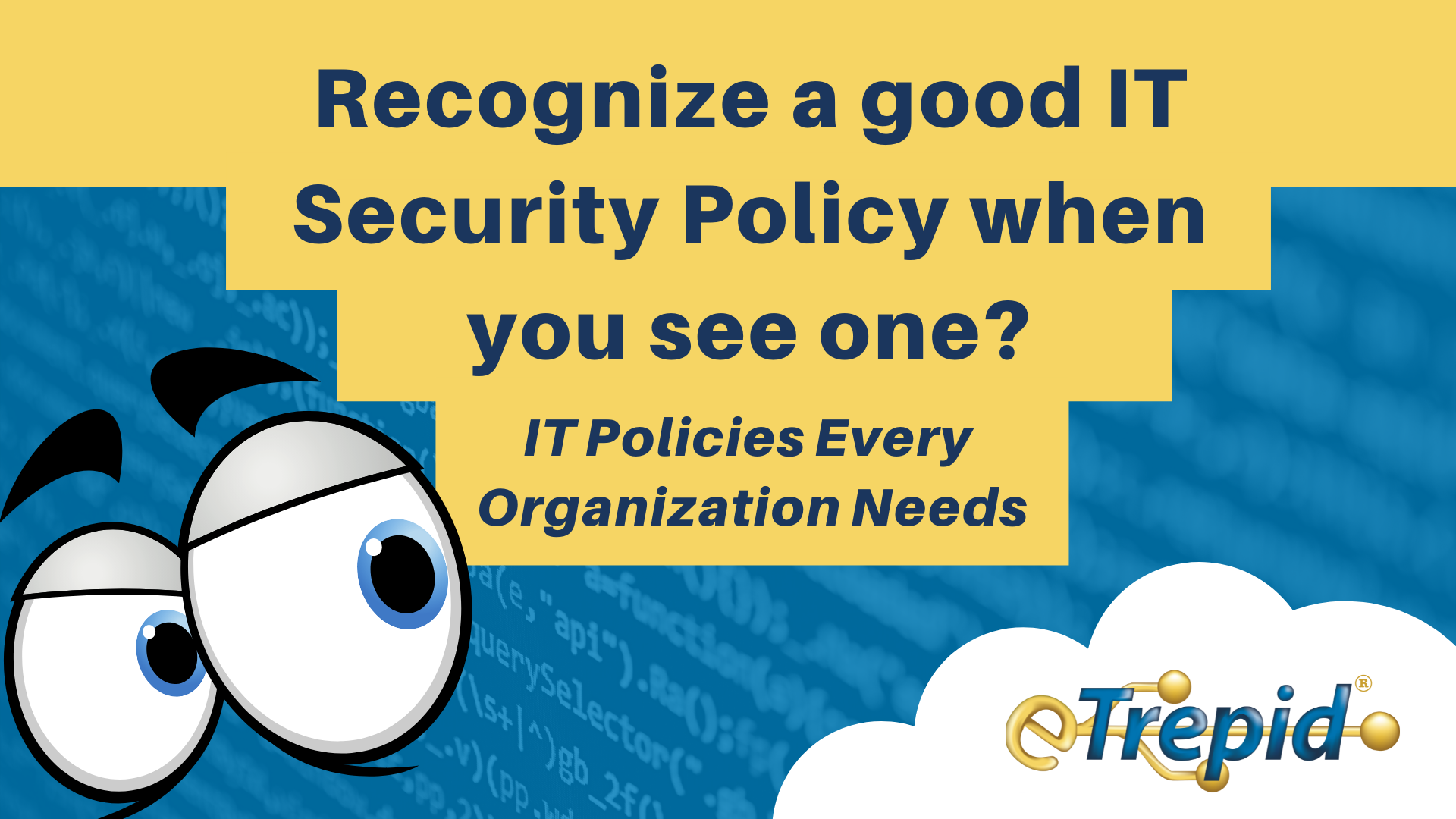IT Policies Every Organization Needs
Small and medium-sized businesses need a well-designed, documented IT Security Policy that clearly defines their cybersecurity position and ensures systems and data protection. Companies who skip implementing their IT Security Policy simply don't understand today’s threat or the level of protection a web Security Program can deliver. Here we explain how to get started developing a powerful IT Security Policy for your company.

In the 1920s, professional bank robber and jewel thief Willie Sutton successfully carried out a string of high-profile robberies across the U.S., enthralling the nation with his immaculate style of dress, impeccable manners, and daring daytime heists. After finally being apprehended in the early 1930s, Sutton was asked why he robbed banks and simply replied: "Because that's where the money is."
A hundred years later, this adage is still true – only the location of the "money" has changed. Instead of trying to carry out risky in-person bank robberies to steal cash, criminals have evolved their methods to target digital assets because "that's where the money is."
As a cybersecurity company, you might say we're biased, but let's look at these staggering statistics for 2020:
- Malware attacks increased by 358%
- Ransomware attacks increased by 435%
- 1 new victim every 10 seconds
If that's not enough, by 2025 cybercrime is projected to cost a staggering $10.5 trillion worldwide, annually.
That's because every year, cybercriminals target businesses that store and process client data. Organizations that maintain critical infrastructure operations, and even government institutions are frequent targets, too – no entity is inherently safe.
With so many new cybersecurity risks emerging, companies need to address the growing threat of cybercrime and take steps to protect their business systems and company data. But how?
Just like the banks took a stance and upgraded their security methods to prevent robberies like those committed by Sutton, businesses should integrate IT security policies that strengthen their defensive integrity and ensure the security of their assets.
Information Security Policies
Information Security Policies are guidelines that help focus an organization's IT security on the areas that matter most. Like a bank vault that opens once a day or the CCTV system monitoring its entry points, Information Security Policies establish and enforce best practices that help prevent criminal breaches and outline steps organizations should take if a breach occurs.
These policies serve as the foundation of an organization's cybersecurity strategy. Some of the functions that Information Security Policies deliver include:
- Identifying potential cybersecurity threats and organizational risk.
- Clearly defining the roles and responsibilities of IT security personnel to increase efficiency and effectiveness.
- Establishing team member security procedures, including user access methods.
- Setting standards for security report generation.
- Implementing effective Incident Response Plans for unpreventable breach scenarios.
- Develop accountability procedures to ensure IT security staff are performing vital tasks.
- Identifying applicable legal and ethical responsibilities to ensure regulatory compliance with digital security laws.
In addition to the functions listed above, Information Security Policies provide the mechanisms that companies need to respond to phishing, malware, and ransomware attacks before they can hijack systems and wreak havoc on critical operations.
How to Develop Information Security Policies
Every organization should have a comprehensive set of Information Security Policies specifically tailored to the needs of their operation. These policies should be developed with the help of digital security professionals and should intersect to form a bedrock of cybersecurity that organizations can further build upon.
Each Information Security Policy can be as broad or as narrow as is needed, but companies should develop all of these policies with the following structural elements addressed:
1. Purpose: Clearly defining the broad organizational goal of an Information Security Policy is the first step in development. Generally, these policies will serve purposes like:
a. To protect company systems from breaches
b. To protect brand reputation
c. To ensure regulatory compliance
Keep in mind that the objective of individual policies themselves tend to be highly specialized or intended for particular security purposes, so organizations can be somewhat ambiguous in defining the broad IT security policy’s purpose.
2. Target: This step in policy development identifies the personnel to which the policy applies. Depending on the goals and purposes of the policy, this might be company-wide, departmental, or intended for project teams. When identifying the entities the Information Security Policy applies to, it is essential to follow through completely. This process will likewise help identify potential gaps, such as third-party vendors that help a business process valuable consumer data.
3. Objectives: In contrast to policy purpose, this step in Information Security Policy development outlines the specific IT effect the policy is intended to achieve. These functions typically fall into one of three categories:
a. Data Confidentiality – to secure data from unauthorized access
b. Data Integrity – to ensure data is complete and accurate
c. System Availability – to ensure IT systems are available when needed
4. Access: This step identifies the individuals in an organization with authorized access to policy applicable data, who is authorized to share that data, and under what circumstances that data can be shared. It is important to remember that these factors are not always up to the organization – data privacy laws are complex, are often sector-specific, and absolutely supersede any organizational preferences. Companies must be thorough and accurately identify the regulations applicable to them when establishing authorized access and sharing standards.
5. Data Classification: Classifying data into separate risk categories helps organizations prioritize Information Security Policies that intersect and operate simultaneously. For example, a security policy that governs how an organization manages specific confidential datasets may also apply to their public data management, but their public data management policies should never supersede confidential data policies. This step also helps an organization identify which datasets might be more damaging to a company if compromised and thus need additional protection measures.
6. Data Management: In conjunction with data classification, Security Policies should clearly define how data in different risk categories are managed. This will include the specific privacy regulations applicable to an organization, the kind of data in question, and the intersection with other policies. In addition, this part of the policy development process should identify data storage procedures, data transfer procedures, and how data is backed up.
7. Training: Probably the most important part of policy development, staff training on Information Security Policies is essential to successful policy implementation. If team members do not know the security protocols expected of them, they cannot be expected to perform them reliably. For example, an Information Security Policy aimed at preventing phishing attacks should include comprehensive training that teaches team members how to identify phishing threats, how to respond to them, and how to react in the event of a breach. Team training on security policies should be extensive, routine, and well-funded.
8. Roles and Responsibilities: Identifying the roles and responsibilities of individual team members (and communicating this with team members) are critical to ensuring that a policy is implemented effectively and functions as intended. This should include team member system access responsibilities, chain of notification and action in response to possible breach scenarios, and the general expectations for maintaining cybersecurity best practices.
Things to Remember
The beginning and end of an organization's digital security lie in the effectiveness of its Information Security Policies. Companies should work with security experts to develop comprehensive Security Policies that meet the business's individual needs while also maintaining compliance with any applicable data privacy laws for their sector. In addition, organizations should remember to keep their policies flexible – as digital security risks continue to evolve over time, so should a company's response regarding security measures.
Criminals will always target "where the money is," – and knowing this actually makes it easier to focus cybersecurity defenses on protecting an organization's most valuable digital assets. Want to know more about protecting your most valuable assets. A simple conversation can get you headed in the right direction.
Find out how to enhance your company's response with a Change Management Policy.


.png)
Leave A Comment